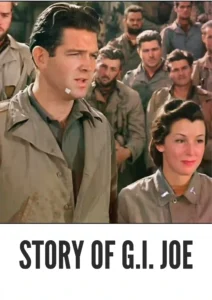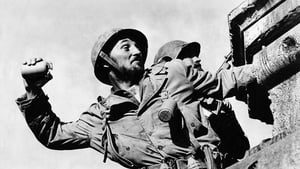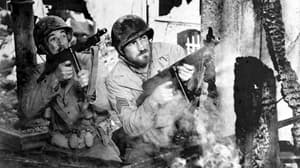Video Sources 0 Views

Synopsis
War, Brotherhood, and Sacrifice: Story of G.I. Joe (1945) in Living Color

Step into the mud, chaos, and camaraderie of World War II with the newly colorized “Story of G.I. Joe” (1945), a landmark war drama that brings the realities of the American infantryman to life. This immersive film, directed by William A. Wellman, is based on the real-life experiences of Pulitzer Prize-winning war correspondent Ernie Pyle. Now, with advanced colorization, every trench, uniform, and battlefield moment is more vivid and immediate, making this essential viewing for war movie enthusiasts and history buffs alike.
Story of G.I. Joe: A Chronicle of Courage and Humanity
“Story of G.I. Joe” follows the journey of Ernie Pyle, played by Burgess Meredith, as he embeds with Company C, 18th Infantry, U.S. Army. From the dusty roads of North Africa to the rain-soaked trenches of Italy, Pyle documents the daily lives, struggles, and sacrifices of the ordinary soldiers he comes to know as brothers. Among them is Lt. Bill Walker, portrayed by a young and magnetic Robert Mitchum, whose leadership and vulnerability anchor the platoon through the war’s relentless hardships.
The film eschews traditional plot structures, instead offering an episodic, almost documentary-like portrayal of the infantryman’s experience. Audiences witness the company’s baptism by fire at the Battle of Kasserine Pass, the grinding stalemate at Monte Cassino, and the fleeting moments of joy and heartbreak that punctuate their journey. From makeshift weddings in bombed-out trucks to Christmas dinners scrounged from rations, the film’s power lies in its intimate, authentic character moments.
A Cast That Brings History to Life
The ensemble cast delivers deeply human performances, making the soldiers’ struggles and bonds palpable:
-
Robert Mitchum as Lt. Bill Walker
-
Burgess Meredith as Ernie Pyle
-
Freddie Steele as Sgt. Warnicki
-
Wally Cassell as Private Dondaro
-
John R. Reilly as Private Mew
-
William Murphy as Private Murphy
Each actor brings a unique dimension to their role, from the haunted resilience of Walker to the quiet observation of Pyle, whose columns gave a voice to the “dogfaces” of the war.
Genre and Cinematic Impact
“Story of G.I. Joe” is more than a war film—it’s a frontline drama that blends realism, pathos, and understated heroism. The movie set a new standard for authenticity in combat films, focusing on the ordinary soldier’s perspective rather than grand strategy or heroics. Its influence can be seen in later classics like “Saving Private Ryan” and “Band of Brothers,” which echo its commitment to portraying war’s human cost.
Historical Context and Legacy
Released in the summer of 1945, just before the end of World War II, “Story of G.I. Joe” resonated deeply with audiences who had lived through the conflict. The film’s depiction of hardship, loss, and fleeting hope reflected the reality faced by millions of servicemen and their families.
Ernie Pyle’s reporting, which inspired the screenplay, brought the war home to readers with empathy and honesty. The movie honors his legacy by refusing to glamorize battle, instead focusing on the resilience and vulnerability of the men on the ground. Robert Mitchum’s breakout performance as Walker earned him an Academy Award nomination and launched his career as a Hollywood icon.
Colorization: Bringing History to a New Generation
The colorized edition of “Story of G.I. Joe” breathes new life into this classic, using modern digital techniques to enhance every frame. The mud, uniforms, and battered landscapes now appear with striking realism, making the soldiers’ world more tangible and immediate. The restoration process involved careful research to ensure historical accuracy in the color palette, from the olive drab of the G.I. uniforms to the muted tones of the Italian countryside.
Technical Details
-
Director: William A. Wellman
-
Screenplay: Leopold Atlas, Guy Endore, Philip Stevenson
-
Based on: Columns by Ernie Pyle
-
Cinematography: Russell Metty
-
Production Company: Lester Cowan Productions
-
Distributed by: United Artists
-
Runtime: 108 minutes
Download Specifications
-
Format: MP4
-
Resolution: HD (1080p)
-
Compatibility: Works on smartphones, tablets, computers, and smart TVs
Critical Reception and Enduring Influence
“Story of G.I. Joe” was hailed for its realism and emotional depth, raising the bar for war films. Critics praised its refusal to sentimentalize combat, instead highlighting the bonds between men and the psychological toll of battle. The film’s final scenes, marked by loss and quiet gratitude, remain among the most powerful in cinema history.
Its influence endures, not just as a war movie, but as a tribute to the ordinary people who bear the extraordinary burdens of conflict. The film’s cyclical structure and focus on small moments of humanity set it apart from other movies of its era.
Frequently Asked Questions
Q: Is “Story of G.I. Joe” based on true events?
A: Yes, the film is inspired by the real-life experiences and columns of Ernie Pyle, who reported from the front lines during WWII.
Q: What makes the colorized version special?
A: The new colorization brings historical detail and emotional immediacy to the film, making it accessible to modern audiences while preserving its authenticity.
Q: Who are the leading actors?
A: Robert Mitchum and Burgess Meredith deliver standout performances as Lt. Bill Walker and Ernie Pyle.
Q: What is the main theme of the film?
A: The film explores the endurance, sacrifice, and camaraderie of ordinary soldiers during WWII.
Q: Where can I download the colorized version?
A: The HD colorized version is available for download in MP4 format, compatible with most devices.
Download Now and Experience the Frontline in HD Color!
Witness the unforgettable journey of Company C and Ernie Pyle in “Story of G.I. Joe”—now in stunning color.














